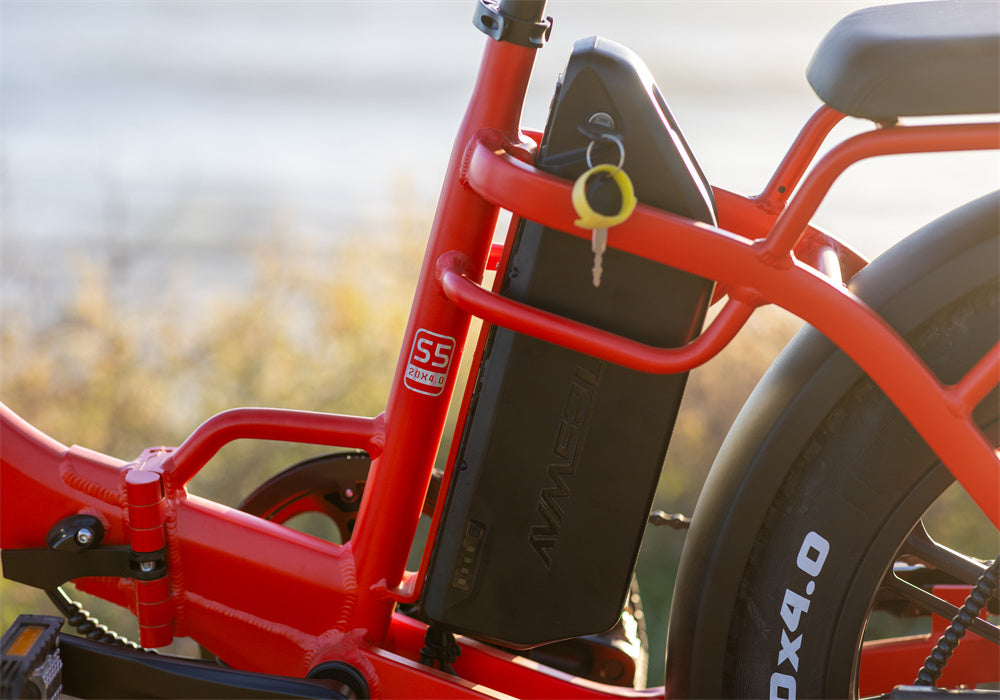Prepare Your Electric Bike for Storage
Before putting your electric bike away for the winter, it’s crucial to prepare it properly. This step ensures that the components are protected from potential damage caused by freezing temperatures, moisture, and lack of use.
1. Thoroughly Clean the Bike
-
A clean bike is a healthy bike. Dirt, grime, and moisture can lead to corrosion or wear if left untreated during storage.
-
Use a gentle bike cleaner or mild soap and water to remove dirt from the frame, wheels, and drivetrain.
-
Pay special attention to the chain, cassette, and gears, as these areas accumulate grease and debris.
-
Avoid using high-pressure washers, as they can force water into sensitive components.
-
Once cleaned, dry the bike thoroughly with a soft cloth to prevent rust.
2. Inspect for Damage or Wear
-
Conduct a detailed inspection of your electric bike to identify any issues that may worsen over time.
-
Check the tires for cracks, cuts, or low tread depth.
-
Examine the brake pads and rotors to ensure they are in good condition.
-
Inspect the frame for chips, cracks, or signs of wear.
-
Ensure all bolts and screws are tightened securely.
3. Lubricate Moving Parts
Lubricating the drivetrain and other moving components helps prevent rust and ensures smooth operation when you’re ready to ride again.
-
Use a high-quality bike-specific lubricant on the chain, derailleur, and pivot points.
-
Wipe off any excess lubricant to avoid attracting dust or debris during storage.
SEE ALSO Can You Ride an Electric Bike Without Pedaling?

Battery Care for Winter Storage
The battery is the heart of your electric bike, and taking proper care of it during winter is essential to maintaining its performance and lifespan.
1. Charge the Battery to Optimal Levels
Before storing your bike, ensure the ebike battery is charged to around 50-70%. Storing a fully discharged battery can cause it to lose capacity, while storing it fully charged may lead to overvoltage stress.
2. Remove the Battery
If possible, detach the battery from the bike and store it indoors in a cool, dry location. This helps protect it from extreme temperatures and moisture.
3. Avoid Freezing Temperatures
Lithium-ion batteries are sensitive to cold weather. Avoid leaving your electric bike or its battery in an unheated garage or shed where temperatures may drop below freezing.
Find the Right Storage Location
Choosing the right spot to store your electric bike during the winter is crucial to prevent damage from environmental factors.
1. Store in a Dry, Temperature-Controlled Space
A garage, basement, or storage room is ideal for keeping your bike safe from the elements. Avoid outdoor sheds or exposed areas where moisture and freezing temperatures can cause damage.
2. Protect Against Moisture
Humidity can lead to rust and corrosion. Use a bike cover or storage bag to shield your bike from dust and moisture. If you’re storing your bike in a damp area, consider using a dehumidifier.
3. Use a Bike Stand
Storing your electric bike upright on a bike stand prevents the tires from developing flat spots and protects delicate components from pressure or damage.
Maintain the Tires
Proper tire care during winter storage helps prevent flat spots and extends the lifespan of your tires.
Inflate Tires to the Recommended Pressure
Check the manufacturer’s guidelines for the recommended tire pressure and inflate accordingly. Underinflated tires can develop flat spots when left stationary for extended periods.
Avoid Direct Contact with Cold Floors
Place your bike on a mat or hang it from a wall-mounted rack to prevent the tires from coming into contact with cold concrete floors.
Protect the Electrical Components
Moisture and cold temperatures can harm the electrical systems of your electric bike. Follow these tips to safeguard them during storage.
1. Disconnect Electrical Connections
Unplug any removable cables or connectors to prevent corrosion. Use protective caps if available.
2. Cover the Display and Control Panel
Use a soft cloth or silicone cover to protect the display and control panel from dust and moisture.
Regular Checkups During Storage
Even while your electric bike is in storage, occasional maintenance checks can help ensure it’s ready to ride when the weather improves.
1. Recharge the Battery Periodically
Lithium-ion batteries naturally discharge over time. Check the battery every 1-2 months and recharge it to maintain optimal levels.
2. Inspect for Moisture or Rust
Check the bike periodically for signs of moisture, rust, or other issues that may have developed during storage.
Preparing Your Electric Bike for Spring
When the winter season ends, a few simple steps can get your bike ready for the road.
1. Perform a Full Inspection
Check the frame, tires, brakes, and drivetrain for any signs of wear or damage that may have occurred during storage.
2. Recharge the Battery
Ensure the battery is fully charged before your first ride. Reattach it securely to the bike.
3. Test the Electrical System
Run a quick test of the motor, display, and other electrical components to confirm everything is functioning correctly.
Conclusion
Ready to tackle any terrain, the Tesway Electric Bike is like your favorite playlist—smooth, reliable, and always ready to roll. With its powerful motor and sleek design, it turns uphill struggles into downhill fun. Why just ride when you can Tesway your day? 🚴♀️✨
FAQs
Should I remove the battery for winter storage?
Yes, if possible, remove the battery and store it indoors in a cool, dry place to protect it from extreme temperatures.
Do I need a special bike cover for winter storage?
A bike cover or storage bag designed for indoor use can help protect your bike from dust and moisture. If storing outdoors, use a weatherproof cover.
Is it necessary to lubricate the bike before storing it?
Yes, lubricating the chain and moving parts helps prevent rust and ensures smooth operation when you’re ready to ride again.








Share:
Reduce Fuel Costs: Save on Gas with an Electric Bike
How to Find the Right Charger for Your Electric Bike